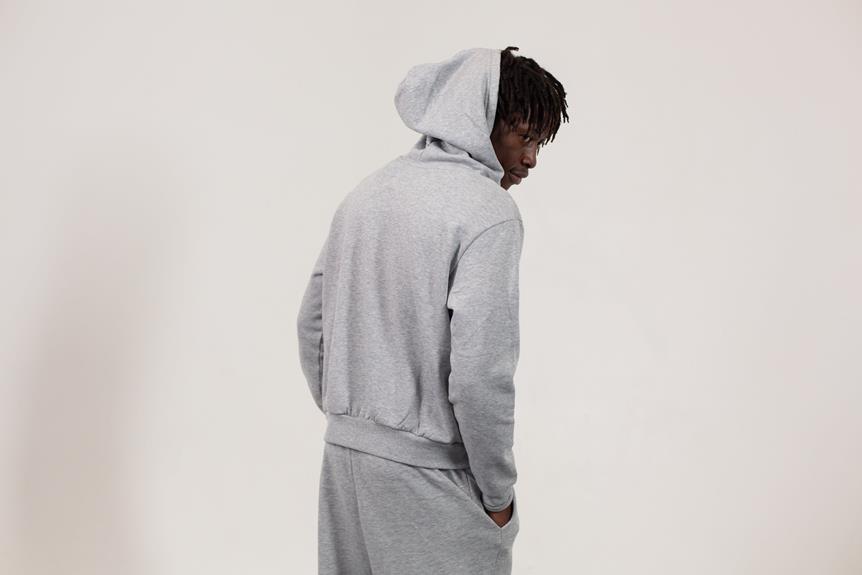Looking to optimize your athletic performance? Choosing the right fabrics for your sportswear is essential. Understanding the characteristics of different fabrics can significantly impact your comfort and overall performance during physical activities.
From moisture-wicking materials to breathable fabrics and eco-friendly options, the right choice can make all the difference. Let's explore the key factors to consider when selecting sportswear fabrics to ensure you're equipped with the best gear for your active lifestyle.
Key Takeaways
- The right fabric choice is important for performance and comfort during physical activity
- Moisture-wicking fabrics like nylon and polyester keep you dry and prevent discomfort
- Compression fabrics enhance muscle support, improve blood circulation, and reduce muscle fatigue
- Durability, flexibility, and eco-friendly options like organic cotton and bamboo are ideal for sportswear
Importance of Fabric Choice
You should prioritize the right fabric choice for your sportswear to optimize performance and comfort during physical activity. Choosing the right fabric can make a huge difference in performance, comfort, and longevity, so it's important to understand the options available.
When it comes to eco-friendly fabric choices, look for materials like organic cotton, bamboo, or recycled polyester. These options not only benefit the environment but also provide comfort and breathability during workouts.
For those seeking performance-enhancing fabric technologies, consider materials like spandex for flexibility, moisture-wicking fabrics such as nylon or polyester to keep you dry, and compression fabrics like elastane to improve blood circulation and reduce muscle fatigue.
Understanding the properties of each fabric and how they align with your specific physical activities is crucial in making an informed decision. By selecting the right fabric for your sportswear, you can enhance your performance, improve comfort, and ensure the longevity of your workout gear.
Performance of Moisture-Wicking Fabrics
Moisture-wicking fabrics such as nylon or polyester effectively draw sweat away from your skin, keeping you dry and comfortable during intense physical activity. This sweat absorption ability is a key feature for sportswear, as it helps to prevent discomfort and chafing caused by excess moisture.
When sweat is efficiently pulled away from your skin, it evaporates more quickly, aiding in maintaining a more stable body temperature.
Furthermore, moisture-wicking fabrics often incorporate odor control properties. By pulling sweat away from your skin and allowing it to evaporate more rapidly, these fabrics can help minimize the growth of odor-causing bacteria. This is particularly beneficial during extended workouts or in hot conditions where sweat accumulation and bacterial growth are more likely.
Breathable Fabrics for Comfort
When it comes to sportswear, breathable fabrics play a crucial role in enhancing your comfort and performance.
Moisture-wicking fabrics help keep you dry by drawing sweat away from your skin, while lightweight materials provide the agility you need for optimal movement.
Additionally, ventilation in sportswear fabrics allows for increased airflow, ensuring that you stay cool and comfortable during your activities.
Moisture-Wicking for Dryness
How can sportswear fabrics keep you dry and comfortable during intense workouts?
When it comes to moisture-wicking for dryness, breathable fabrics play a crucial role in ensuring your comfort. Here's how they do it:
- Sweat Management: Innovative fabric technology enables efficient sweat absorption and dispersion, keeping your skin dry and comfortable.
- Quick Drying: These fabrics facilitate rapid evaporation of moisture, ensuring that sweat doesn't linger on your skin, preventing chafing and discomfort.
- Moisture Control: By drawing sweat away from your body and allowing it to evaporate quickly, these fabrics help regulate your body temperature, preventing overheating and enhancing your overall performance.
Lightweight for Agility
To further enhance your comfort during intense workouts, breathable fabrics are essential for maintaining dryness and agility. Lightweight, breathable sportswear allows for ease of movement, making it a key component for agility during physical activities. Fabrics with stretchy comfort and quick-drying technology are especially beneficial as they provide the flexibility needed for agile movements and help to wick away moisture, keeping you dry and comfortable.
| Features | Description | Benefits |
|---|---|---|
| Stretchy Comfort | Allows for ease of movement | Facilitates agile and dynamic performance |
| Quick Drying Tech | Wicks away moisture quickly | Maintains dryness and comfort during workouts |
Selecting sportswear with these features will not only enhance your agility but also contribute to an overall comfortable and enjoyable workout experience.
Ventilation for Airflow
Ensure your sportswear allows air to circulate with breathable fabrics for maximum comfort during your workouts. When considering ventilation for airflow, look for fabrics that incorporate advanced ventilation technology and airflow management. Here are three key factors to consider:
- Moisture-wicking properties: Look for sportswear fabrics designed to wick moisture away from your skin, allowing it to evaporate more quickly and keeping you dry and comfortable during intense workouts.
- Mesh panels: Sportswear with strategically placed mesh panels allows for enhanced breathability in targeted areas, promoting airflow and ventilation where you need it most.
- Lightweight construction: Lightweight fabrics not only contribute to agility but also aid in airflow management, ensuring that your sportswear doesn't hinder ventilation during your workouts.
Durability and Flexibility in Sportswear
When selecting fabrics for sportswear, prioritize durability and flexibility to ensure optimal performance and comfort during physical activity. Durability is crucial to ensure that your sportswear can withstand the rigors of intense workouts and frequent washings without losing its shape or functionality. Look for fabrics that are known for their strength and resilience, such as nylon, polyester, or spandex blends. These materials offer excellent resistance to wear and tear, making them ideal for sportswear that needs to endure frequent use.
In addition to durability, stretchability is equally important for sportswear. Opt for fabrics that offer a good amount of stretch, allowing for unrestricted movement during exercise. Spandex, elastane, and lycra are popular choices for adding stretch and flexibility to sportswear. These fabrics provide the necessary elasticity to accommodate a wide range of motion, ensuring that your clothing moves with your body rather than restricting it.
When shopping for sportswear, pay attention to the fabric composition and look for materials that strike a balance between durability and flexibility. By prioritizing these qualities, you can ensure that your sportswear not only performs well but also lasts longer, making it a worthwhile investment for your athletic pursuits.
Understanding Compression Fabrics
Prioritize fabrics with compression properties for sportswear, as they can enhance muscle support and improve blood circulation during physical activity. This aids in reducing muscle fatigue and enhancing overall performance, making them a valuable addition to your athletic wardrobe.
- Fabric Technology: Compression fabrics are engineered using advanced fabric technology to provide a snug fit that supports muscles and reduces vibration during exercise.
- Compression Benefits: These fabrics apply gentle pressure to the skin, which helps improve blood circulation, reduce muscle soreness, and enhance recovery post-exercise.
- Performance Enhancement: By stabilizing muscles and increasing oxygen delivery, compression fabrics can improve endurance and overall athletic performance, making them ideal for various sports and physical activities.
Understanding compression fabrics is essential for athletes who seek to optimize their performance and recovery. When selecting sportswear, consider the fabric's compression properties and the benefits they offer in terms of muscle support, blood circulation, and overall athletic performance.
Eco-Friendly Fabric Options
Consider incorporating eco-friendly fabric options into your sportswear choices to align with your sustainability values and reduce environmental impact. Sustainable options such as organic cotton, bamboo fabric, and recycled polyester are gaining popularity in the sportswear industry due to their positive environmental impact.
Organic cotton is grown without the use of synthetic pesticides and fertilizers, reducing water consumption and preventing harmful chemicals from entering the environment.
Bamboo fabric is derived from bamboo grass, a highly sustainable and renewable resource that requires minimal water and no pesticides to grow. Additionally, bamboo fabric is biodegradable, making it an excellent eco-friendly choice.
Recycled polyester is created from post-consumer plastic bottles, reducing the amount of plastic waste in landfills and oceans.
Frequently Asked Questions
How Do Different Fabrics Affect the Overall Performance of Sportswear, Such as Speed, Agility, and Endurance?
Different fabrics impact sportswear performance. Moisture-wicking materials keep you dry, while breathable compression enhances agility and endurance. Fabrics like polyester, spandex, and nylon are ideal for sportswear, providing the necessary support and flexibility for optimal performance.
Are There Any Specific Fabric Blends That Are Better for Different Types of Sports or Physical Activities?
When considering fabric blends for different sports or physical activities, you'll find that durability, breathability, moisture-wicking, and flexibility are essential. Specific blends, like nylon-spandex for flexibility in yoga, vary based on activity.
What Impact Does Fabric Choice Have on Preventing Odors and Bacteria Growth During Physical Activity?
Choosing the right fabric for sportswear is crucial in preventing odor and bacteria growth. Fabrics with moisture-wicking properties and high breathability requirements are effective in managing sweat and reducing the risk of bacterial proliferation during physical activity.
Can Certain Fabrics Help Regulate Body Temperature and Keep the Wearer Comfortable During Intense Workouts or Outdoor Activities?
Certain fabrics can help regulate body temperature and keep you comfortable during intense workouts. Look for moisture-wicking fabrics that breathe well, provide insulation, offer flexibility, and ensure durability for optimal performance and comfort during physical activities.
Are There Any Special Care Instructions for Maintaining the Quality and Performance of Sportswear Fabrics?
To maintain sportswear fabric quality and durability, follow special washing instructions. Use gentle cycles, cold water, and mild detergent. Avoid fabric softeners and excessive heat. Air dry or use low heat settings. These steps preserve performance and longevity.
- Tetron Fabric for Marine Applications: Durability and Use Cases - June 18, 2025
- Tetron Fabric for Outdoor Furniture: Weather Resistance and Care - June 18, 2025
- Tetron Fabric for Wall Coverings: Style and Application Tips - June 18, 2025





